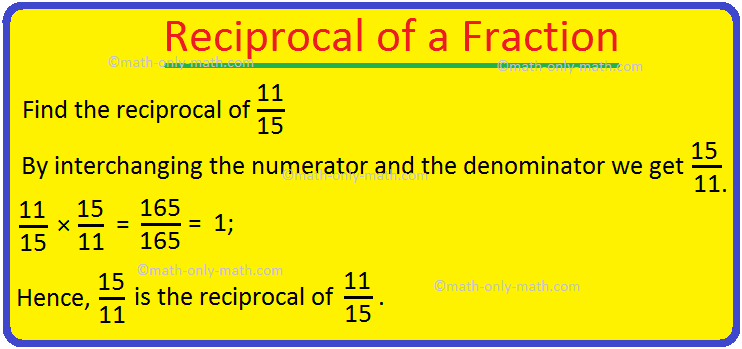Subscribe to our ▶️ YouTube channel 🔴 for the latest videos, updates, and tips.
Reciprocal of a Fraction
Here we will learn reciprocal of a fraction.
Reciprocal of a Number:
Let us learn reciprocal of a number.
Any natural number can be written as \(\frac{number}{1}\)
10 = \(\frac{10}{1}\); 5 = \(\frac{5}{1}\); 23 = \(\frac{23}{1}\); 52 = \(\frac{52}{1}\) and so on.
Reciprocal of \(\frac{10}{1}\) = \(\frac{1}{10}\)
Reciprocal of \(\frac{23}{1}\) = \(\frac{1}{23}\)
Reciprocal of \(\frac{52}{1}\) = \(\frac{1}{52}\)
Reciprocal of \(\frac{16}{1}\) = \(\frac{1}{16}\)
Reciprocal of \(\frac{36}{1}\) = \(\frac{1}{36}\), etc.
Reciprocal of a Fraction:
What is the reciprocal of \(\frac{2}{3}\)?
Reciprocal of a fraction is the fraction inverted.
Therefore, reciprocal of \(\frac{2}{3}\) = \(\frac{3}{2}\)
Reciprocal of \(\frac{5}{6}\) = \(\frac{6}{5}\), etc.
What is \(\frac{1}{4}\) of 4?
We know that \(\frac{1}{4}\) of 4 means \(\frac{1}{4}\) × 4, let us use the rule of repeated addition to find \(\frac{1}{4}\) × 4.
We can say that \(\frac{1}{4}\) is the reciprocal of 4 or 4 is the reciprocal or multiplicative inverse of \(\frac{1}{4}\).
Now, let us consider the multiplication of the following pairs of fractional numbers.
|
\(\frac{3}{7}\) × \(\frac{7}{3}\); |
\(\frac{5}{8}\) × \(\frac{8}{5}\); |
\(\frac{2}{9}\) × \(\frac{9}{2}\) |
We observe that
|
\(\frac{3}{7}\) × \(\frac{7}{3}\) = \(\frac{21}{21}\) = 1; |
\(\frac{5}{8}\) × \(\frac{8}{5}\) = \(\frac{40}{40}\) = 1; |
\(\frac{2}{9}\) × \(\frac{9}{2}\) = \(\frac{18}{18}\) = 1; |
Therefore, if the product of two fractions is 1 we call each fraction as the reciprocal of the other. We can get reciprocal of a fraction by interchanging the numerator and the denominator. The reciprocal of 1 is 1 and there is no reciprocal for 0.
Solved Examples on Reciprocal of a Fraction:
1. Find the reciprocal of \(\frac{11}{15}\)
Solution:
By interchanging the numerator and the denominator we get \(\frac{15}{11}\).
\(\frac{11}{15}\) × \(\frac{15}{11}\) = \(\frac{165}{165}\) = 1;
Hence, \(\frac{15}{11}\) is the reciprocal of \(\frac{11}{15}\).
2. Find the reciprocal of \(\frac{1}{571}\)
Solution:
By interchanging the numerator and the denominator we get \(\frac{571}{1}\).
\(\frac{1}{571}\) × \(\frac{571}{1}\) = \(\frac{571}{571}\) = 1;
Hence, \(\frac{571}{1}\) i.e., 571 is the reciprocal of \(\frac{1}{571}\).
Reciprocal of a Mixed Fraction:
To find the reciprocal of a mixed fraction first we need to convert the mixed fractional number to improper fraction and then interchange the numerator and the denominator of the improper fraction.
Solved Examples on Reciprocal of a mixed fraction:
1. Find the reciprocal of 2\(\frac{5}{9}\)
Solution:
2\(\frac{5}{9}\) is a mixed fraction.
Let's convert the mixed fraction to improper fraction.
2\(\frac{5}{9}\)
= \(\frac{9 × 2 + 5}{9}\)
= \(\frac{23}{9}\)
By interchanging the numerator and the denominator we get \(\frac{9}{23}\).
\(\frac{23}{9}\) × \(\frac{9}{23}\) = \(\frac{207}{207}\) = 1;
Hence, \(\frac{9}{23}\) is the reciprocal of \(\frac{23}{9}\) i.e., 2\(\frac{5}{9}\).
2. Find the reciprocal of 5\(\frac{13}{21}\)
Solution:
5\(\frac{13}{21}\) is a mixed fraction.
Let's convert the mixed fraction to improper fraction.
5\(\frac{13}{21}\)
= \(\frac{21 × 5 + 13}{21}\)
= \(\frac{118}{21}\)
By interchanging the numerator and the denominator we get \(\frac{21}{118}\).
\(\frac{118}{21}\) × \(\frac{21}{118}\) = \(\frac{2478}{2478}\) = 1;
Hence, \(\frac{21}{118}\) is the reciprocal of \(\frac{118}{21}\) i.e., 5\(\frac{13}{21}\).
From Reciprocal of a Fraction to HOME PAGE
Didn't find what you were looking for? Or want to know more information about Math Only Math. Use this Google Search to find what you need.




New! Comments
Have your say about what you just read! Leave me a comment in the box below. Ask a Question or Answer a Question.